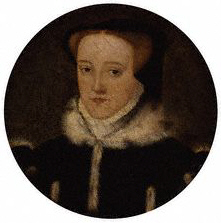Engraving of Lady Jane Grey
done by Willem and Magdalena van de Passe, probably from a portrait
by Hans Holbein which has since been lost.
National Portrait Gallery, London
Black and white portrait identified as Lady Jane
Grey
painted by an unknown artist
Collection of Lord Hastings
Oil on panel - formerly called Lady Jane
Grey
attributed to Master John, c. 1545
National Portrait Gallery, London
Now identified as Catherine Parr because of the crown-shaped brooch worn in the portrait. A similar jewel was included in an inventory of Queen Catherine's belongings.
Portrait said to be of Lady Jane
Grey
by an unknown artist
formerly in the collection of the Earl of Jersey, now destroyed
Detail from the above painting:
Jane's head
Oil painting of Lady Jane Grey
by a contemporary artist
Portrait sometimes identified as Lady Jane
Grey
oil on panel by an unknown artist
National Portrait Gallery, London
Portrait said to be of Lady Jane Grey
by an unknown artist
Painting sometimes called Lady Jane
Grey
by a 16th-century artist
The Execution of Lady Jane Grey
painted by Paul Delaroche
National Gallery of Art, London
Watercolour of Lady Jane Grey
by Herbert Norris
from his book "Costume and Fashion", Volume III, book 2

Battista Spinola, a Genoeses merchant, has left a contemporary report
of Jane's appearance:
'This Jana Groia...is very short and thin, but prettily shaped
and graceful. She has small features and a well made nose, the mouth
flexible and the lips red. The eyebrows are arched and darker than
her hair, which is nearly red. Her eyes are sparkling...her colour
good but freckled...In all, a charming...person...very small and
short."
De Noailles, the French ambassador, who conversed with Jane, found her
:
'...well made', and was impressed by her
'esprit cultivé, dont la modestie rehaussait
extrèmement le mérite.'
Bishop Godwin was not at first much taken with her appearance. He thought
her features 'not
admirable', i. e. not striking, but considered her
'handsome, incredibly learned, very
quick-witted and wise both beyond her sex and above her
age.'
In the years succeeding Jane's death the legend of her beauty grew up and
so held the public
imagination that it was accepted as true. An Italian, writing of her in Queen
Elizabeth's reign,
describes her as pretty, polite and attractive.
An eighteenth-century historian says:
'All the graces in nature conspired to improve the exquisite beauty
of her face...
She was generally called the Queen of Hearts.'
This picture eventually developed into the vision popularized by Harrison
Ainsworth in his novel
The Tower of London, where he describes Lady Jane as tall, slender and
"gracefully bending"
when in talk with an inferior.
Thus the real likeness was gradually obliterated from the public mind. The
only sixteenth-century
picture of Lady Jane which exists (and even that is not absolutely
authenticated), shows her as
full-faced and sandy-haired - "nearly red", as Spinola called it - with large,
rather prominent
brown eyes. The contemporary reports of her appearance and conversation give
the impression
that a lively, natural manner, combined with youthful freshness to make her
appear better looking
than she really was.